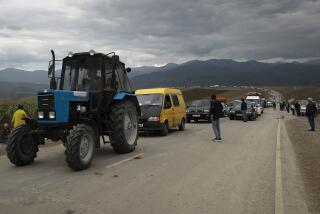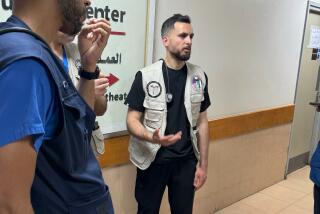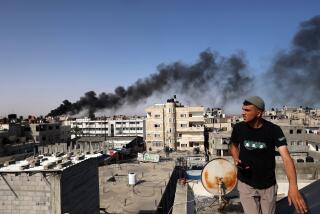The Call to Come âHomeâ : For a Local Surgeon, the First U.S. Relief Flight to Armenia Was a Gruesome Return to His Roots
The calls began coming into the La Canada Flintridge home of Dr. Vartkes and Mary Najarian the first night after the earthquake.
And for good reason. As founder and chairman of Medical Outreach for Soviet Armenians--a nonprofit organization that has sent medical supplies and specialists to Soviet Armenia since 1984--the Armenian-American orthopedic surgeon was one of the first experts contacted by Soviet Armenian officials after the Dec. 7 temblor that killed at least 55,000 and left 300,000 homeless.
âThey called four or five times, and every time the telephone connection was so bad that the only thing I heard was, âWe need antibiotics. We need doctors . . . as soon as possible, as soon as possible,â â Vartkes Najarian recalled Monday, the day after his return from Armenia.
âIt was a nightmare. We were hysterical,â Mary Najarian said. âWe felt like we lost a family.â
Getting the News
Najarian had heard of the disaster that afternoon, although Mary Najarian had tried not to tell her husband until he had seen his last patient of the day.
âI knew it would devastate him,â she said.
But Najarian found out from a patient who entered his Glendale office crying. Overwhelmed by the news that his problem-plagued homeland had suffered yet another major calamity, he canceled his appointments for the rest of the week.
The Najarians got no sleep that night.
And the next day Vartkes Najarian received a call from the State Department, which asked him to be one of two Armenian-American doctors to join a 27-member rescue team being assembled in Washington. The other physician was Dr. Garo Tertzakian, a Santa Ana kidney specialist. Dr. Robert Gale, the UCLA bone-marrow transplant expert who helped treat victims of the 1986 Chernobyl nuclear disaster, also was on the flight, as were trauma specialists and eight search-and-rescue dogs.
The morning before he left for Washington, the Najarians rushed to Glendale Memorial Hospital to purchase 100 pounds of antibiotics and anesthetics--Ancef, Xylocaine and various cortisone preparations. He said he packed them in with his personal belongings because he âknew they (the hospitals) needed it and didnât know how much they would get elsewhere.â
Medical Outreach provided an additional $38,000 worth of antibiotics and $600,000 worth of hospital supplies, such as disposable syringes, catheters, sterile sheets and bandages and stethoscopes, which it had purchased several months before.
Loading the Plane
The Najariansâ four children--Ara, 28, Armen, 25, Raffi, 22, and Maro, 18--and a band of their friends worked through the night and much of the next day at LAX to load the provisions on an Aeroflot plane chartered by World Vision, an international relief society.
At 3 p.m. Friday, the second day after the earthquake, Soviet approval of the U.S. rescue mission was granted, and early Saturday morning, Dec. 10, the first official U.S. government relief flight to Armenia took off from Washington, stopping in Newfoundland, Ireland and Yugoslavia before reaching the Armenian capital of Yerevan in the wee hours of Sunday.
The 27 team members and eight dogs piled into a bus for a rocky ride to Leninakan, Armeniaâs second-largest city with a population of 250,000. Though Leninakan was only 50 miles from Yerevan, the drive took five hours, the last mile taking nearly an hour because of the congestion caused by evacuating residents in cars piled high with mattresses, utensils and other belongings, and trucks filled with coffins.
Over the next several days, Najarian visited the cities of Spitak, Stepanavan and Kirovagan and the shepherding village of Nalband, where 500 of the estimated 4,000 dead were children, killed when their school collapsed.
Recalling the most gruesome moment, Najarian, seated behind a paper-cluttered desk in his Glendale office, bowed his head and closed his eyes.
Thousands of Coffins
It was in Spitak, where the quake claimed 90% of the population of 20,000. Thousands of wooden coffins--red and white ones for children, gray or brown ones for adults--were crowded in a makeshift morgue set up on a sports stadium. Sobbing and grief-stricken survivors were running from one coffin to another looking for their loved ones.
Najarian peered inside several of the wooden boxes himself, he said, to observe the condition of the bodies--the crushing injuries, dismemberment and disfigurement.
âThe feeling I had was one of hopelessness, really,â said Najarian, 58, who lost nearly all his relatives in the 1915 Turkish massacre of thousands of Armenians. âI said there are some people who consider themselves chosen by God. Maybe we are the ones cursed by God.â
Although he was born in Lebanon, where his parents, the only family members to survive the massacre, had fled after the killings, the physician, like many Armenian-Americans, burns with nationalistic zeal for the tiny republic with a 2,600-year history of being invaded, plundered and conquered by foreigners.
That identification with his peopleâs struggles for independence has been the driving force behind his efforts to improve health care in Armenia, he said--and the reason why he dropped everything to rush to its aid.
Dr. Richard Kasper, an Armenian-American ophthalmologist and vice chairman of Medical Outreach for Soviet Armenians, said some members of the local Armenian community might consider Najarian âself-aggrandizingâ because his enthusiasm âcomes on so strong. . . . But I think the man has a tremendous amount to offer and a real desire to help. He is extremely committed to the advancement of the people of Soviet Armenia.â
Although he was prepared to don surgical greens, Najarian said by the time he arrived in Yerevan, most of the acute surgery had been done. On his tour of several hospitals, he consulted with Armenian doctors on several cases, chiefly involving patients with fractured arm, leg and hip bones.
And to his dismay, the planeload of medical supplies purchased by his organization, Medical Outreach, has been sitting in Moscow since last Wednesday, still carrying its precious 45,000-pound cargo. âWe donât know why (Soviet authorities) wonât let it through. No one can tell us,â he said. âIf it is not going to reach Armenia, it is going to break everyoneâs heart.â
The hospitals he saw in Yerevan seemed to have everything under control, Najarian said. âThey just need the technology--and the medical supplies.â
He said he has no immediate plans to return to Armenia. âAt this point, I think I can be more helpful here,â he said, arranging, for instance, for specialists to fit amputees with artificial limbs and psychiatrists and counselors to tend to survivorsâ emotional wounds.
Xerox Childrenâs Books
He also is trying to obtain several copying machines to send to Armenian schools, which lost nearly all their books in the quake. âThere are 120,000 students who need books,â he said. âWith the Xerox machines, they can Xerox the books they have left,â instead of waiting months for new ones to be printed.
With an office abuzz with constant phone calls to airlines to ship more emergency supplies and drug company representatives bringing in donations of medicines--and a waiting room full of patients who needed to be seen--Najarianâs sense of urgency seemed as strong as ever.
âI know the world is going to forget (this disaster) in no time. Memory is short and consciousness is changeable. But I want to keep hopes high.â
More to Read
Sign up for Essential California
The most important California stories and recommendations in your inbox every morning.
You may occasionally receive promotional content from the Los Angeles Times.











